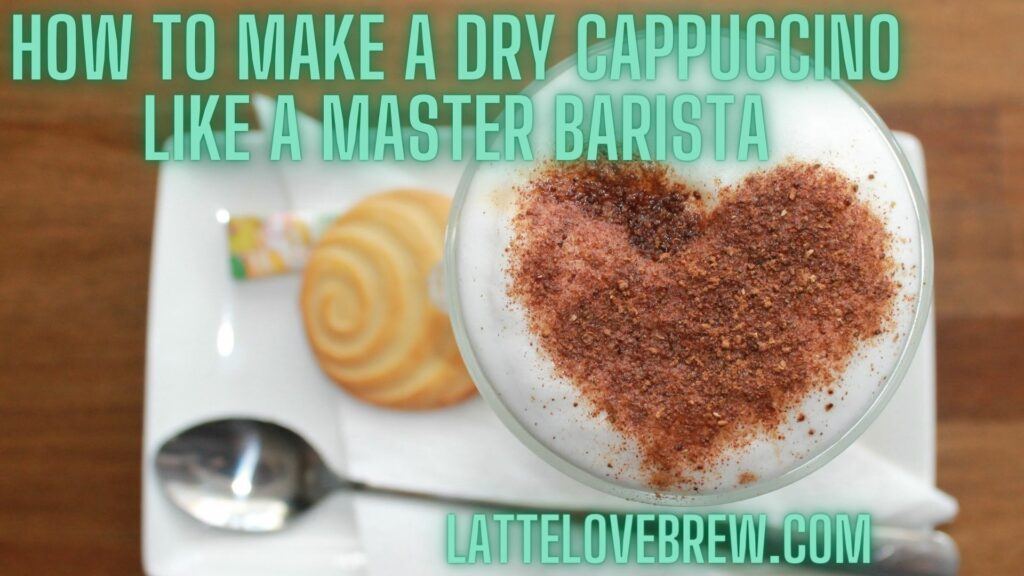Last updated on January 22nd, 2024 at 13:11
Learning how to make a dry cappuccino like a professional barista will not only help you to make a great dry cappuccino, it will help you to perfect all the other cappuccino beverages, including bone dry cappuccino, wet cappuccino and super wet cappuccino.
The key is in mastering the espresso – which is why I have put a particular focus on this area.
Keep reading to learn how to make the perfect dry cappuccino.
How To Make A Dry Cappuccino Like A Professional Barista
Table Of Contents
- 1 How To Make A Dry Cappuccino Like A Professional Barista
- 2 How To Make A Dry Cappuccino – The Instructions Step By Step
- 2.1 Ingredients Needed For Making A Dry Cappuccino
- 2.2 Step 1: Ensure Your Equipment Is Clean
- 2.3 Step 2: Check Your Espresso Machine Settings
- 2.4 Step 3: Weigh Your Coffee Grounds
- 2.5 Step 4: Grind And Tamp
- 2.6 Step 5: Pull Your Shot
- 2.7 Step 6: Steam Your Milk
- 2.8 Step 7: Pour And Enjoy Your Dry Cappuccino
- 3 Frequently Asked Questions About How To Make A Dry Cappuccino
- 4 Final Thoughts – How To Make A Dry Cappuccino
It is not at all difficult to make a dry cappuccino; one of the key skills is making a great espresso.
Before I jump in and start giving a tutorial on how to make a dry cappuccino, let’s first talk about what a dry cappuccino is.
What Is A Dry Cappuccino?
The difference between a dry cappuccino, a bone dry cappuccino, a wet cappuccino and a super wet cappuccino is the amount of steamed milk this is used. It is that simple.
Learn how to make one, and you can make them all!
- Bone Dry Cappuccino: A shot of espresso, no steamed milk and an equal amount of foam as there is espresso.
- Dry Cappuccino: A shot of espresso with half as much steamed milk as a wet cappuccino and extra microfoam.
- Wet Cappuccino: A shot of espresso, steamed milk and microfoam in equal proportions.
- Super Wet Cappuccino: A shot of espresso topped with steamed milk, no microfoam.
At the heart of the difference between all the drinks is the amount of milk and foam.

Read: Dry foam vs wet foam coffee
How To Make A Dry Cappuccino – The Instructions Step By Step
Let’s get to it and get you making an amazing dry cappuccino. To make it every bit as good as your local barista you will need an espresso machine.
A full-blown professional one is not necessary; a good quality home espresso machine with a milk steaming wand will get you pulling top quality shots. A moka pot and Aeropress don’t quite make the same quality and make as my best description, “espresso like” beverages.
Ingredients Needed For Making A Dry Cappuccino
You need only two ingredients for making this coffee drink, which are:
- Top quality specialty grade dark roasted coffee beans.
- Whole fat milk.
Ensure that your coffee beans are freshly roasted as this will help you to pull a better quality shot that has a nice thick crema on top.
Step 1: Ensure Your Equipment Is Clean
As a matter of habit, keep your brewing equipment clean and in tip-top condition and ready for making coffee. This includes your grinder. Tiny little coffee particles and oil from your grinder can affect the quality of your coffee.
Personally,
I keep my grinder empty and never store my beans in the hopper as I can keep my beans fresher by storing them in a professional coffee canister with an airtight lid and one way valve and store it in my fridge.
I can also give my grinder a brush down and blow out as well as a quick wipe after every use ensuring it is clean and clear of oils and grinds.
Step 2: Check Your Espresso Machine Settings
Check the water temperature and ensure your brewing temperature is 96F (205F), the perfect temperature for pulling a great espresso.
Ensure the water pressure is at 9 bars (130 PSI).
Step 3: Weigh Your Coffee Grounds
It is best that you weigh your coffee grounds as whole beans and then grind them later. The final weight is same due to the mass being the same, be they ground or whole.
It is good practice to weigh your beans as whole as you will reduce the opportunity for oxidization and help them to stay fresher for a little longer.
For a single shot, weigh 20 grams of coffee beans and 40 grams for a double shot.
Step 4: Grind And Tamp
Grind your coffee beans to a fine grind of 200 microns, which will most likely be the smallest grind setting on your grinds.
A good quality grinder will help you get a better quality grind. The best type is a ceramic burr grinder as you will get a better quality even grind. The ceramic material will cause your beans to “cook” less while being ground and thus of a better quality when you are ready to brew them.
When you have ground your beans, put your grounds in your portafilter and tamp them well and evenly. Don’t over tamp, or under tamp. Tamping is a key skill. Approximately 30 kg of pressure is enough to tamp well.

Read: Wet cappuccino vs latte
Step 5: Pull Your Shot
With your scales below your cup, tare your digital coffee scales and pull your shot and time it.
For a single shot your beverage should be ready when it reaches 30 grams; for a double shot it should be ready once your scale reaches 60 grams.
The brewing time, or pull time as it is known, should take 25 seconds +/- 5 seconds. If your shot is outside this range, it will not taste as good as it could.
If your shot takes too long to pull, the most likely cause is your grounds being too small. Try again with a larger grind size. It also likely be slightly over brewed and a little too bitter.
If your shot is too quickly pulled, the reason is likely to be your grind size being too large. Adjust your grind size and try a smaller size. If it pulls too quickly, it will probably taste on the sour side.
Step 6: Steam Your Milk
This is a step that you can complete while pulling your shot.
Add your milk to your milk jug using whole fat milk. Tilt your milk jug at an angle and dip your steaming wand below the surface and steam your milk. Move your wand through your milk from top to bottom to steam your milk well.
Watch for a whirlpool effect and listen for that familiar screeching sound. When you hear it, your milk is ready.
To froth your milk, dip your steaming wand a tiny bit below the surface and steam, moving your wand up and down slightly to create the steamed microfoam.
Steam your milk a little to turn and mix some microfoam into your milk to create a silk-like texture and re-froth your milk a little to have an abundance of microfoam for your coffee beverage
Step 7: Pour And Enjoy Your Dry Cappuccino
Once your shot is ready, add a little milk to it, approximately half as much milk as there is espresso. Use a teaspoon to scoop on the microfoam. Add a good amount of milk foam, approximately an equal amount of foam as there is espresso and milk.
Optional, sprinkle on cocoa powder and/or chocolate shavings.
Frequently Asked Questions About How To Make A Dry Cappuccino
What Does It Mean To Make A Dry Cappuccino?
All cappuccino beverages have shots of espresso and a layer of foamed milk. A dry cappuccino has a reduced amount of steamed milk and more foam. By comparison, a wet cappuccino, also known as a traditional cappuccino, has more milk and less foam. Typically, a traditional cappuccino has coffee, milk and foam in equal ratios.
Can You Get Cappuccino Without Milk?
Can You Order A Cappuccino Without Foam?
Yes, a cappuccino without foam is an extra wet or super wet cappuccino. The difference between a super wet cappuccino and a latte is a latte has some foamed milk added on top while a super wet cappuccino has none at all.
What Is A Traditional Cappuccino?
A traditional Italian cappuccino is a coffee drink that contains equal amounts of espresso, steamed milk and an equal amount of milk foam. It can be made with either a single or double espresso shot and is always poured in a 1:1:1 ratio of espresso, steamed milk and milk foam.
What Does A Dry Coffee Mean?
A dry coffee is a foamy coffee beverage that is made with a reduced amount of milk and an increased amount of microfoam.
It is not a coffee drink that has no milk, just approximately half as much milk as a regular cappuccino. The reduced amount of milk is compensated with a larger layer of milk foam.
A bone dry cappuccino has no milk.
What Is A Double Cappuccino?
A double cappuccino is a classic cappuccino that is made with a double shot of espresso, twice as much milk and twice as much milk foam. It is a big coffee with a big taste.
Final Thoughts – How To Make A Dry Cappuccino
As you have seen in this article, learning how to make a dry cappuccino and making a truly amazing one is easy. It only takes a little concentration, some know how and a little practice.
Did you make a dry cappuccino or a bone dry cappuccino?
Join our online coffee community on Facebook/Meta and share your coffee creations, images, tips and selfies with us all. We look forward to hearing from you.







